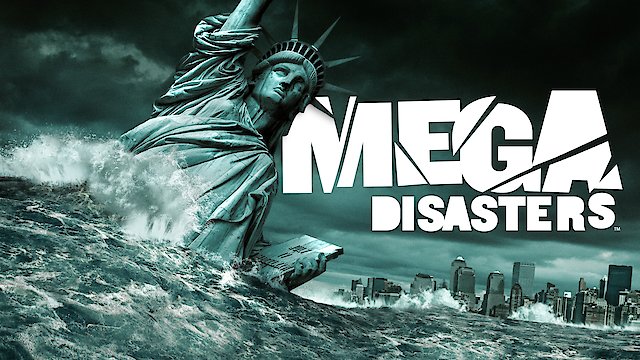
Mega Disasters
Where to Watch Mega Disasters
Watch Mega Disasters Season 3 Episode 11 Now
Watch Mega Disasters Season 3 Episode 8 Now
Watch Mega Disasters Season 3 Episode 7 Now
Watch Mega Disasters Season 3 Episode 6 Now
Watch Mega Disasters Season 3 Episode 5 Now
Watch Mega Disasters Season 3 Episode 4 Now
Watch Mega Disasters Season 3 Episode 3 Now
Watch Mega Disasters Season 3 Episode 2 Now
Watch Mega Disasters Season 3 Episode 1 Now

Mega Disasters was a documentary television series that aired on the History channel beginning in 2006. The show explored some of the most significant natural and man-made disasters in history, their causes, and the impact they had on humanity and the environment. With a focus on both historical events and potential future catastrophes, Mega Disasters combined scientific analysis, expert interviews, and computer-generated imagery to bring these terrifying scenarios to life.
Throughout its run, each episode of Mega Disasters examined a different calamity or series of related disasters. The show delved into well-known events such as earthquakes, tsunamis, volcanic eruptions, meteor impacts, and hurricanes. It also discussed less familiar but equally devastating occurrences like massive solar storms, potential asteroid strikes, and hypothetical super volcano eruptions. By analyzing past occurrences, the series sought to understand the factors that led to each event and evaluate the potential risks for a similar disaster to occur in the future.
One of the key aspects of the series was its scientific grounding. Mega Disasters worked with geologists, meteorologists, engineers, historians, and other experts to ensure the information presented was accurate and up-to-date. This created an educational aspect to the series, making it a resource for viewers interested in the science of disaster prediction and prevention.
The series also highlighted the latest in disaster preparedness and mitigation techniques. Viewers learned how advancements in technology and planning could potentially save lives and reduce the damage caused by future disasters. Episodes often concluded with an overview of what is being done around the world to protect populations and infrastructure from the destructive forces of nature and human error.
Mega Disasters was well-received for its use of CGI to re-enact catastrophic events. The visual recreations were detailed and realistic, providing a visceral sense of the power and scale of these disasters that could be difficult to grasp through numbers and statistics alone. The animation was used not only to depict what had happened in the past but also to model predictions for future events based on scientific data.
The choice of scenarios covered in the series was diverse and thought-provoking. For example, while the show examined notorious historical incidents like the eruption of Mount Vesuvius in 79 AD or the San Francisco earthquake of 1906, it also discussed more speculative scenarios. These included the possibility of a New Madrid Seismic Zone earthquake of equal magnitude to the 1811-1812 events in the United States, the aftermath of a hypothetical breach of the Hoover Dam, or the global consequences of the Yellowstone Caldera erupting in a super volcanic event.
What set Mega Disasters apart from other disaster-themed programming was its comprehensive approach. Not only did the show replay terrifying moments of destruction, but it also considered the often complex human and environmental factors that exacerbated these events. Episodes frequently looked into the social and economic repercussions of disasters, acknowledging the long-term challenges faced by communities during the recovery process.
The show's narrative tended to oscillate between an examination of historical events to cautionary tales about what the future might hold. This instilled a sense of urgency regarding the need for continued research, planning, and investment in preventive measures. In doing so, Mega Disasters sought to raise awareness about the constant and often unpredictable threats posed by natural and artificial disasters.
With its dramatic reconstructions, expert commentary, and engaging storytelling, Mega Disasters appealed to a wide range of audiences. Whether you were a history buff, a science enthusiast, or just someone fascinated by the sheer power of nature and the fragility of human civilization, the series offered something of value. It succeeded in walking the line between entertainment and education, leaving viewers with a greater appreciation of the world's dynamism and the necessity to respect and prepare for its potential for catastrophe.
Beyond its informative content, the show served as a sobering reminder of the importance of learning from the past. By analyzing prior disasters, the series potentially paved the way for better responses to similar situations in the future. Mega Disasters positioned itself as both a record of humanity's struggles against the forces of nature and a call to action for ongoing vigilance in the face of the unknown.
In conclusion, Mega Disasters was a thought-provoking series that captivated its audience with in-depth examinations of the worst events in the annals of history while exploring the possibilities of the future. It was a show that underscored the power of the natural world and the ongoing challenge of living in harmony with it.
Mega Disasters is a series categorized as a canceled. Spanning 3 seasons with a total of 35 episodes, the show debuted on 2006. The series has earned a mostly positive reviews from both critics and viewers. The IMDb score stands at 7.6.
How to Watch Mega Disasters
How can I watch Mega Disasters online? Mega Disasters is available on History with seasons and full episodes. You can also watch Mega Disasters on demand at Apple TV Channels, History Vault, Prime Video online.
